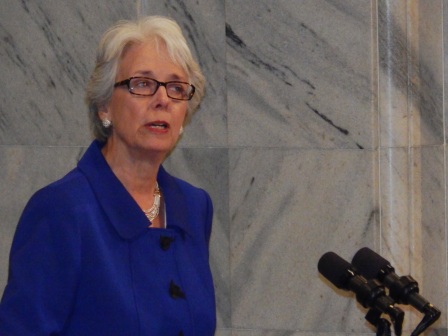Amendment XIX
The right of citizens of the United States to vote shall not be denied or abridged by the United States or by any state on account of sex.
Congress shall have power to enforce this article by appropriate legislation.
"Passed by Congress June 4, 1919, and ratified on August 18, 1920, the 19th amendment guarantees all American women the right to vote. Achieving this milestone required a lengthy and difficult struggle; victory took decades of agitation and protest. Beginning in the mid-19th century, several generations of woman suffrage supporters lectured, wrote, marched, lobbied, and practiced civil disobedience to achieve what many Americans considered a radical change of the Constitution. Few early supporters lived to see final victory in 1920." (Source: National Archives)
Today, Lt. Governor Crit Luallen will take part in a commemoration at the Kentucky State Fair of the 95th anniversary of the passage of the 19th Amendment to the US Constitution which gave women the right to vote.
What would the women who fought the long battle to get the vote make of universal suffrage in 2015?
Ninety five years after the passage of the vote, 53% of registered voters are women. They vote in greater percentages than men. At the last presidential election, 67.3% of eligible women reported voting compared to 59.7% of eligible men who reported voting.
"Women lean Democratic by 52%-36%; men are evenly divided (44% identify as Democrats or lean Democratic; 43% affiliate with or lean toward the GOP). Gender differences are evident in nearly all subgroups: For instance, Republicans lead among married men (51%-38%), while married women are evenly divided (44% Republican, 44% Democratic). Democrats hold a substantial advantage among all unmarried adults, but their lead in leaned partisan identification is greater among unmarried women (57%-29%) than among unmarried men (51%-34%)." Gallup: A deep dive into party affiliation
The biggest change in recent years, according to Gallup, is the increasing number of voters who identify themselves as independent. While a majority of women voters continue to identify as Democratic, between 1992 and 2014, independent identification has risen from 33% to 35%. For those who self identify as leaning toward one party or the other, Democratic leaning among women has remained stable at 52%. Leaning toward Republican, as reported by Pew, dropped from 39% to 36% between 1992 and 2014. Men are more likely to identify as independent at 45%. Their leanings toward either party are roughly equal (44% Democratic, 43% Republican).
With a woman serving as Kentucky lieutenant governor and all candidates for lieutenant governor on the November ballot women, the early suffragettes would be cautiously optimistic. |







